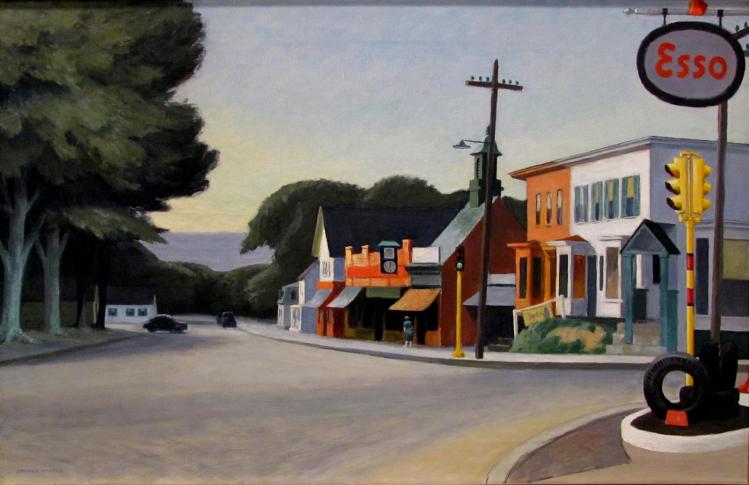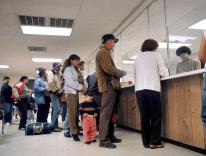
Work has me driving from Boston to New York more often than I would like, but it’s a leafy drive on long, straight roads. On a recent trip I stopped for a burger and beer at a nondescript bar in a quiet Western Massachusetts town, the kind of town where you never pay for parking, and where, I’d imagine, you know your neighbors. You might even grow your own vegetables and spend some evenings sitting on the porch.
Americans have always admired small-town life; Mayberry is stuck in our consciousness. It goes without saying that the bigotry-sensors of my fellow urbanites are tuned for maximum sensitivity when they head into small, mainly white towns. But still, who doesn’t breathe a little sigh of longing when they hear about the hedge-funder who gave it all up and opened a bed-and-breakfast or antiques shop on some languorous, walkable Main Street?
Sitting at the bar, waiting for my burger, I heard a similar sigh when I told my bartender, a kind, sad woman in her twenties, that I live in Boston. Her eyes flashed soft hunger. Your life, she said, must be so exciting. She seemed to wish we could trade places.
But why? In a place like hers, the cost of living is much lower. You can walk safely at night, and always find a quiet place to read. No parking tickets or cattle-car subway rides. The bartender told me she had recently been released from prison. She’d had some sort of injury, taken her prescribed fentanyl, become addicted, and acquired more from a drug dealer after her prescription ran out. Her young son had been taken from her when she was arrested for possession, and now she was allowed only supervised visits. She was tending bar to save up enough money for her own apartment. Her mother, from what I gathered, was in similar straits, and the child lived with his grandfather.
The crack epidemic ravaged poor urban communities in the 1980s. I grew up knowing this, and thinking it seemed safely distant. Urban blight was the natural consequence of economic dislocation, as manufacturing jobs moved overseas. Racial enmity contributed, in some cases. The deep despair of poor, inner-city “others” is overdetermined. We’ve countered it chiefly by locking up a small nation’s worth of men and women who have responded to the despair by buying and selling drugs.
But now there’s something new to explain, another far-away calamity—the tornado path that opioids are cutting through small-town America. Why is Mayberry now despairing? Last year New York magazine published a beautiful, searing reflection on the opioid crisis in America by Andrew Sullivan. He delved into the history and specifics of this poppy-based drug family, and came back with some profound insights. The sharpest was this: opioids are drugs that help you withdraw from life. Cocaine and alcohol, in their ways, can intensify your experience of people and things. Opioids allow you to slip away. It’s a drug for those who don’t want to play the game anymore, who feel disposed of and useless. Opioids also duplicate the natural chemicals our bodies produce in response to sex, friendship, holding our children, etc. They are a chemical community for the lonely and isolated.
But why rural America in particular? After all, city people can also feel isolated and alienated. One difference, I think, is that in 2019, urban white people are more likely than rural white people to see success within grasping distance. It is a grave mistake to see things this way, but it is an understandable mistake. The public culture we share inevitably communicates certain assumptions about what constitutes human excellence. In 2019, our shared picture of excellence—or at least of success—is Manhattan, or maybe San Francisco. Penthouses rather than picket fences. Money. Glamour. Culturally and racially diverse but uniformly attractive friends. CrossFit. Foreign vacations. Good taste. If you live a thousand miles from all that, if you’re overweight and poor, unfashionable and unsophisticated, living in a trailer park, what is there for you? How can you excel? By buying new threads at Walmart? Waiting tables at Applebee’s? Right.
Social media and mass culture carry our vision of excellence to the farthest corners of the humblest homes in the most out-of-the-way towns. One’s own failure to thrive according to that vision, to replicate the lifestyles of the coastal elite, will haunt you no matter where you are in this country. You’ll see that image of success in your dreams, and wake to find yourself still in an unnoticed little town, with no shot at the Good Life as depicted on Instagram. In the absence of hope and self-respect, Big America offers its losers a massive raft of stultifying consolations: Mountain Dew and Pornhub, Doritos and Four Loko, Facebook and Snapchat. When those are no longer enough, pharmaceutical firms in China and America stand ready to provide you with a pill-delivered slumber.
Our longing for personal acceptance—the sense of embrace that opioids simulate—is deeply intertwined with our longing for social status, for success and excellence. There is a natural loneliness in failure. It makes us want to run away and hide. Accidents of birth and upbringing have led me to believe I can thrive in the global-information age. Accidents of birth and upbringing have led my bartender to believe that she cannot. But it is our media-saturated, fame-obsessed culture that has led many people like her to think that outside of the world I inhabit, there is no path to excellence. This is a lie.
Many feel as if they have been thrown naked into a gladiatorial arena of endless financial and social competition, overseen by enlightened Caesars in Dolce, Gabbana, and Manolo Blahnik. It takes luck and willful rebellion to follow any other path. But we need other paths. Badly. We need paths that let people say, “Yes, I may not be rich or young or beautiful, but I’m generous and faithful. I live a good life.” The resources required for this kind of excellence are more widely distributed than those required to secure the life we see on our screens. We need to have ways of valuing ourselves and our neighbors that are not indexed to the market. No society is decent if it cannot draw a picture of a life well lived in a small, unattractive house.
This is something that government policy cannot achieve. By all means, tax the millionaires and spread the money around—it would do the country a lot of good. But short of perfect equality, which will never exist as long as some people are born smarter, healthier, or better-looking than others, we still need models of the good life that don’t depend on good luck. Let’s do all we can to eradicate grinding poverty, but let’s also combat the insidious, usually implicit idea that the good life is just a function of material resources.
In March of last year, Hillary Clinton explained her electoral defeat to a crowd in India: “I won the places that represent two-thirds of America’s gross domestic product, so I won the places that are optimistic, diverse, dynamic, moving forward. And his whole campaign, ‘Make America Great Again,’ was looking backwards.” I don’t know what to say to you if you feel no shudder of disgust at this identification of the GDP with moral progress.
As a matter of simple fact, the qualities and activities that make for success and sexiness have only some overlap with the virtues that make (most) people happy. Most of us still know this at some level, but the pop culture we all share does not reflect it. Wealth and celebrity have eclipsed or colonized everything, including our politics. In our pop music, reality television, Hollywood blockbusters, Met galas, and Oscars, we choose to glorify a way of life that is accessible to only a few, and hollow even for the ones who get it. It’s bad for all of us. But it’s worst for those who believe that the good life belongs only to those who live somewhere else.
Please email comments to [email protected] and join the conversation on our Facebook page.
Previous Story
Ask Cleo
Next Story
The Ones Ignored

